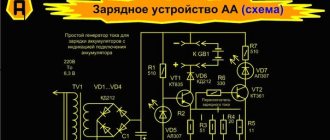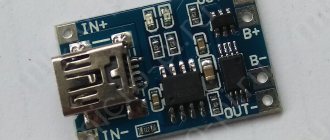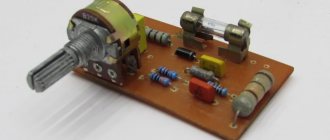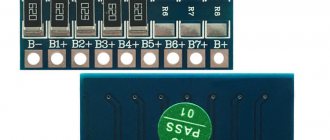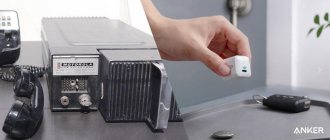Types of chargers for car batteries
There are different types of battery chargers on the market. Let's look at 8 options plus a common classification.
Pulse charger for car battery
A pulse battery charger charges with high-frequency current. Devices of this type are miniature.
The following variants of pulse memory are distinguished:
- Manual chargers require human control. You need to manually adjust the current strength, charging time and voltage.
- Automatic are programmed chargers that independently determine the battery parameters. They are able to automatically regulate the entire charging process.
- Semi-automatic or semi-automatic are charging systems that perform part of the processes automatically. You will have to control the charging time manually.
Pulse charging of the battery comes in three options:
- Charging with constant pulse current.
- Filling with energy using constant voltage.
- A combination of the two options above.
Sometimes there are situations when you need to start the car right away. A powerful pulse “charger” for the battery does this in the “ BOOST ” mode.
Please pay attention to this at the time of purchase. With BOOST, charging will occur in 5-10 minutes. This is enough to start the car.
This mode is recommended for use in emergency situations. Frequent use leads to deterioration of the electrolyte after 2-3 months.
Pre-charger for car battery
It is required when it is impossible to disconnect the battery from the network. The main advantage is that you do not need to remove the battery from the car. Startup after connection is not possible.
Starting device for battery
Allows you to start the engine in a matter of minutes!
The device is compact and easy to use! It is enough to connect the crocodiles of the starting charger to the battery terminals. The required amount of current will be generated and the car will start.
Starting charger for car battery
Allows you to charge the battery and start the car immediately after connecting to the network.
Three types of charger for batteries:
- Household ones are chargers that are used in the garage. Operate from a 12 volt network. There are 6-volt devices on the market. They are also capable of starting a motorcycle.
- Professional are devices in contact with a 12-24 volt network.
Such devices are identified by the presence of thick wires.
Transformer charger for car battery
The main key figure here is the transformer. Its disadvantage is its dimensions. The principle of operation is to reduce the voltage according to the principle of a conventional converter. That is, from high to low. Large charging currents take part in charging the battery.
Recommended for use in the garage!
Automatic car battery charger
The auto charger for a 12-volt battery is regulated by the program. Smart electronics will do everything according to the correct algorithm and protect the battery from various dangers.
This device charges and cleans the battery from lead sulfate. I call this phenomenon desulfation. The device is protected against incorrect connection of wires and short circuit of terminals. Thanks to the built-in controller, the optimal charging mode is selected.
Automatic chargers have 4 types of operation:
- Battery charging mode. Its stages: The first step is to charge up to 14.6 volts with a stable current of 0.1 s (C is the battery capacity in Ah). Then comes charging with a voltage of 14.6 volts. This happens until the current drops to 0.02 C. Then it maintains a stable voltage of 13.8 volts until it reaches 0.01. At the end, the battery is charged. If the voltage drops to 12.7 V, the above circuit is repeated.
- Desulfation. Operating cycle: 5 seconds of charging with a current of 0.1 C. This is followed by a 10-second discharge with a current of 0.01. This occurs until the battery voltage reaches 14.6 volts. Then normal charging occurs.
- Battery Test. This mode makes it possible to find out how much the power source is discharged. After a current load of 0.01 C, the voltage at the contacts is measured for 15 seconds.
- Control-training cycle mode. The battery discharges to a voltage of 10.8 volts. Then the specified mode is activated. Having received data on the charging current and time, the system determines the battery capacity. The data will be displayed on the device display.
There are usually two types of automatic chargers.
5-stage memory
Here's what it does:
- Charges the battery up to 80 percent!
- Perform full charging with reduced current
- Preventatively keeps the charge at 95-100%
- Eliminates sulfation on plates
- They do battery diagnostics.
8-stage automatic charger
The device has an eight-step charging cycle.
Here's what his job is:
- Due to charge-discharge, the plates are cleaned.
- The power supply is tested for functionality.
- The battery is charged to 80% capacity.
- Charging occurs smoothly up to one hundred percent, with minimal current.
- A check is made to see how well the battery holds a charge.
- All electrolyte separation is eliminated.
- Capacity is maintained at maximum.
- A preventive charge is carried out up to 95-100 percent!
Second classification of battery charger
Types of settings:
- Manual - you configure everything yourself.
- Automatic - everything you need is already configured by a computer program.
According to the car battery charging scale
The car battery charging indicator is as follows:
- Switches
- LED
- Digital
By connection type:
- Connected from a regular 220 volt network.
- Connected to the cigarette lighter. This type is the most convenient because it is small in size and portable.
According to the duration of a car battery charge:
- Slow - perform charging during the day.
- Fast - charge in 2-3 hours.
- Air conditioning. Typically, chargers with this speed charge the battery within 1 hour.
Does a car owner need a spare part and why?
Many car enthusiasts drive for years without connecting the battery to a charger. Behind this is the practice of regularly replacing the battery with a new one; meanwhile, even direct instructions for cars require periodic recharging of the battery. This extends the life of the device and prevents performance deterioration.
All vehicles (except hybrid, electric and experimental) are equipped with lead-acid batteries. Today there are various technologies that improve the classic circuit, but they all require recharging.
The nature of the vehicle's operation also affects the mode of connecting the battery to the charger:
- When storing batteries, charge them to 100% once a year (twice a year in cold conditions).
- When using, it is advisable to charge the battery every 2 to 3 months.
When the battery is installed in its normal place in the car, it has a strong impact when the engine starts (spin up the starter and crankshaft flywheel). This is followed by charging from the generator.
However, there are other current consumers in the car - they take away part of the power, and the battery does not always have time to charge by an amount equal to the output. This results in constant undercharging, which is very harmful to a lead-acid power supply.
Expert opinion
Torsunov Pavel Maksimovich
The most vulnerable batteries are those that operate in start-stop mode. This means that after turning on the engine, the owner drives the car a short distance (for example, to work), where he parks for the whole day and, in the best case, repeats the trip in the evening in the reverse order. That is, there is a maximum discharge when the ignition is turned on, but charging from the generator is minimal.
The laws of chemistry and physics are inexorable: car batteries with lead electrodes and sulfuric acid as an electrolyte cannot be stored for a long time in a discharged state. And if it was still possible to do this with the old antimony models, even at home, then modern maintenance-free batteries with thickened electrolyte or fiberglass impregnated with sulfuric acid will simply “die” without timely charging.
New chargers for car batteries
Every year new memories appear. Main list of new products:
- CTEK MXS 7.0
- CTEK MXS 5.0 POLAR
- Bosch C7
- CTEK MXS 5.0
- Noco Genius G7200EU
- CTEK CT START STOP
- CTEK MXS 5.0 TEST & CHARGE
- CTEK MXS 3.8
- Bosch C3
- Noco Genius G3500EU
Which charger for a car battery is better?
It's difficult to choose the best. All chargers work great. A brief overview of popular models is presented below.
Oboronpribor ZU-75A
This type of charger is quite simple. There is nothing fancy about it. There is simply a transformer with switching of the terminals of the secondary or secondary winding. On the case, the 4A/6A toggle switch is responsible for switching. In addition to the transformer, it contains a diode bridge and an ammeter measuring device.
This device is unpretentious. It can be left in a cold, damp garage. It's unlikely to break.
According to the manufacturer, such a power source is designed to work with ninety-amp batteries. But in practice this is 65 amperes maximum!
Do not use the charger to charge gel and AGM batteries. This is due to the fact that at the end of charging the voltage level at the terminals can be about 15 volts. Such voltage can cause damage to these batteries.
FUBAG MICRO 80/12
Among many others, this charger stands out for its miniature size. It is capable of charging different batteries. Has many charging options. Built-in sulfation mode. Thanks to it you can charge a completely zero power source!
Pendant 715A
The peculiarity of the device is the presence of a “power supply”. When the current does not automatically decrease at the outputs, turning off at the end of the charging process, but maintains a certain voltage level at the contacts.
Drivers find a lot of uses for this mode. For example, you can power a carrier with 12 volts or revive seemingly unusable batteries.
Using automatic charging, the driver simply needs to set the ammeter to the highest charging current, determined from the battery capacity.
Elitech UPZ 30/120
The device works with a 12-24 volt battery. The device has two charging options:
1) Normal – allows you to work with a maintenance-free battery;
2) Fast - makes it possible to recharge lead-acid batteries, because it has a high current;
The presence of a special start mode toggle switch disables automatic protection. This allows the device to deliver as much as 120 A to the load. This is normal for a compact charger model.
FUBAG COLD START 300/12
This charger weighs only 1.5 kg! Delivers current up to 50 A. Allows you to start at a time when the starter needs little current.
To select the charging mode, press the “mode” button. After this, the charger itself will set the necessary parameters. If desired, voltage and current can be displayed on the main display. If there is a malfunction, an error message will appear.
The best manufacturers of car battery chargers
Below are the brands of battery chargers.
Charger brands:
- Airline
- Aiken
- Hyundai
- Katun
- Pendant
- Cedar
- Yulmart
- Sonar
- AUCHAN
- Bison
- Golden eagle
- Resanta
- Stack
- Electronics
- Ermak
- Imax
- Arduino
- Patriot
- Mercedes
- Pole
- Telwin
- Caliber
- Sorokin
Why is it important to use a quality power source?
Chargers differ mainly in their element base. In high-quality accessories, energy conversion occurs smoothly without surges in current and voltage, the formation of interference and pulsations. Some charger models are certified with protection against overcurrent, voltage, overload, temperature, short circuit, etc. In the event of danger, the fuse will trip, cutting off power to the device, and in the worst case scenario, only the fuse will blow.
In cheap chargers costing 3-7 USD, manufacturers usually save on all components. The situation is similar with fakes. The absence of anti-aliasing filters and other necessary components in the power circuit loads the power controller inside the smartphone or other device. Ultimately, in optimistic scenarios, the controller or other element on the board burns out and needs to be repaired, which will cost at least 3 times more than a high-quality charger. For example, the same AUKEY PA-U28 or the updated version of AUKEY PA-T9. Therefore, charging must be done with an original charger or a high-quality analogue.
The best automatic chargers and their brief overview
ORION PW150
The simplest device that works with lead-acid batteries. This model stands out among its competitors! The front panel contains only a couple of indicators. This is a charge light and a charging activity diode.
This device, of course, cannot revive zero power supplies, but it is quite capable of raising those who are near death to their feet!
Advantages:
- Great working machine
- Price
- Easy to use
Flaws:
- Very simple mode of operation.
QUATTRO ELEMENTI I-CHARGE 10
This is a top-class charger at a very reasonable price. Easily copes with recharging batteries with a capacity of up to 100 Ah. The initial charging process is carried out with a current of 6.5 A. The device constantly reads data about the state of the battery and gradually selects the mode required for charging. It increases and then increases the current strength. If a breakdown occurs, the device notifies the owner.
Advantages:
- Can notify about breakdown
- Touch screen
- Low power consumption
- Has good cooling
Flaws:
- Small current supply 10A
- The price, although reasonable.
SMART-POWER SP-25N PROFESSIONAL
The charger recharges 12 and 24 volt batteries
Used on an industrial scale. Rarely do ordinary drivers purchase this device.
Advantages of the device:
- Produces good performance despite its small size
- Simple controls that everyone can understand
- Moisture-resistant housing
- Digital display
- Availability of charge indicator
Disadvantages of the device:
- High price tag.
Working methods
All chargers operate according to a certain system of supplying electricity to the terminals. There are models that supply constant, smoothed and pulsating voltage. The supplied electricity has a potential difference between the anodes and cathodes, which causes the direction of current in the battery to change.
When moving to the negative electrode from the positive ones, a redox process occurs, which creates charged electrons with the reverse effect of current inside the battery.
The types of all battery chargers are divided not only by classification, charging speed and application, but also by charging method: constant current, constant voltage, mixed type. Read the instructions carefully and get advice from the seller about what charging method is needed in your case.
The best manual chargers
These devices have manual control. Suitable for resuscitation of zero batteries.
Charger KOLNER KBCH 4
The charger is capable of recharging batteries at 12 volts. There is a built-in unit that protects against short circuits. Charging is detected through special indicators. Using such a charger, you will have to constantly monitor the current and make sure that the electrolyte does not boil away.
The advantages of such a car battery:
- Implemented short circuit protection.
- Reliable and durable.
- The charger is made in a convenient case.
Flaw:
- You will have to constantly monitor how the battery is charging.
Charger SONAR UZP-210
This device has a modern filling in a nineties body. The model is very simple to use. It has two modes for 12 A and 6 A. Charging follows a standard cycle: fast charge, current equalization to standard values. Next comes a transition to buffer mode, and then voltage stabilization occurs.
Advantages:
- High starting current.
- Small dimensions.
- Automatic charging, but with parameters that need to be performed manually.
Minuses:
Couldn't find any cons.
Charger ZPU 135
This is a transformer starting charger, manually adjustable. Maximum charging current 13 amperes. Starting current – 140 A. Ordinary drivers rarely use such a monster. It is usually used in large offices.
Advantage:
- High power.
- Simple controls.
- Acceptable price.
Minuses:
- Lack of short circuit protection.
Brands
Which manufacturers should you prefer?
There is no clear leader in the charger market. Experts often recommend products from the Italian company Telwin
. But the price tag there starts from 12 thousand, which is not affordable for every car enthusiast. This is if we are talking about an original instrument. There is also a Chinese analogue with the same name. It costs less, from 2 thousand, but experts are no longer in a hurry to recommend it.
If you need something cheaper, but no less reliable, consider the German FUBAG
or
QUATTRO ELEMENTI
. Within 5,000 rubles you can get an excellent universal charger that will work in several modes and have additional diagnostic functionality.
Among Russian brands, devices from Avtoelektrika
and
Vympel
. They have both manual and automatic models in the price category from 2 to 10 thousand rubles. These brands specialize in chargers, so they approach the issue of quality with particular scrupulousness.
Bison could not pass by either
,
Patriot
and
Caliber
. Companies produce a wide variety of electrical equipment. Including memory. The brands are Russian, but you should understand that they produce goods in China. There is nothing wrong with this, but you won’t find a lot of rave reviews about these products either.
How to choose a car charger?
- Determine what parameters the power source has. Especially voltage and rated current. Be careful, the new charger should provide a current 12-15% more than the rated current of the battery. The output voltage should be 12 V.
- Select a price range. How much are you willing to pay?
- If the car will leave the garage in the cold season, it is better to take a starting charger.
- Check for a BOOST button. The button makes it possible to start the car engine after just a few minutes of charging. This mode is especially in demand in winter.
- If you plan to charge frequently, it is better to purchase a charger from any popular brand.
How to check a car battery charger?
In some cases, you might think that the charger is acting up. But it is not always the case. Some chargers are simply not designed to charge empty batteries. Residual stress is required here.
A couple of things to pay attention to:
- Make sure that the charger is capable of charging not only a medium-sized battery, but also a completely discharged one.
- Check the fuses if possible.
- If the charger voltage is below 13 volts or it jumps strongly, this means that it is broken.
- Connect any 12-volt device, such as a light bulb, to the charger terminals. If it is on, then the charger is working, if not, then it is broken.
- Check the integrity of the wires and their fastening. If no current flows through the wire, then this is the reason.
You can check your charger using these tips. If you are not good with electronics, then it is best to take the device to a technician at a service center.
Additional functions
What auxiliary options are there?
The simplest device, manual or automatic, simply supplies current to the terminals without diagnosing the battery in any way. If your battery dries out, or the bank in it has shorted, you will never know about it. The best option in this case is a microprocessor charger that can calculate all battery parameters, such as performance, capacity and structural integrity.
It is also preferable to choose a device with a set of protective functions, such as emergency shutdown, protection against current surges and polarity reversals. The more additional functions your memory has, the better protected you are from errors, but you will also have to pay for them separately.
How does a car battery charger work?
The process of charging a car battery is as follows. The charger converts the mains voltage of 220 volts into what is needed to charge the batteries. Next, a constant voltage is supplied to the battery terminals through wires coming from a powerful charger. It can be pulsating or smooth and exceeds the potential difference between the electrodes.
Due to this, current flows inside the battery in the direction opposite to the discharge. Particles of the oxygen molecule are “squeezed out” of the cadmium and penetrate through the electrolyte layer to their original place. This allows you to restore capacity.
The chemical composition of the plates changes during charge and discharge. An electrolyte is a medium where cations and anions pass through. The speed at which current flows inside the battery affects the rate of restoration of the properties of the plates and the charging speed.
The processes proceed quickly, this causes strong gas release and heating. This can damage valuable plates.
Low charging current prolongs the process of capacity restoration. Frequent use of a slow charge increases plate sulfation and reduces capacity. In this regard, it is necessary to take into account the power of the charger and the load supplied to the battery.
Conditions for charging a car battery
Do not use the charger in a damp place or in an unventilated area. The vapors released during the charging process are harmful to the body.
Voltage supplied by the charger
There are three common types of batteries - 6-volt, 12-volt and 24-volt. 6-volt batteries are used on motorcycles with low on-board voltage. 12-volt ones are installed on cars, and 24-volt ones on buses, trucks, and tractors. Therefore, you should choose a charger that operates in the desired voltage range.
The voltage supplied by the charger must ensure the process of capacity restoration. In the case of 12 V, you should set 13.8–14.4 V on the charger to charge to a level of 75–85%. This value is provided by the car's generator. When set to 15 V, the charge level increases to 85–90%, and at 16.3 V to 95–97%.
How to charge a car battery with a charger?
How to use a car battery charger?
Using any charger, whether automatic or manual, comes down to 5 main things:
- Connecting wires to the battery.
- Turn on the memory.
- Setting certain modes.
- And turn on the switch to start charging.
- Disconnecting the charger.
How to connect the charger to the battery?
Charging algorithm for a car battery:
- Please read the operating instructions first.
- Find a well-ventilated area.
- Make sure there are no sources of fire entering the room.
- If you are going to charge the battery outside the car, disconnect the wires.
- Remove the battery.
- Use the special handles to carry the battery to the prepared location.
- Clean the stamps using baking soda and water.
- Do not touch the white residue; it is frozen sulfuric acid.
- Unscrew the plugs on the battery.
- Pour distilled water into each hole to the desired level. This should be done if the battery is not serviceable.
- Close the plugs; if the battery is not equipped with flame arresters, place a wet cloth on the plugs. If the lids are sealed, do not touch them.
- Place the charger as far as possible from the battery.
- Set the output voltage switch of the charger to the voltage transfer position. If the charger has a regulator, set it to the minimum level.
- Connect the charger wires to the battery in accordance with the polarity.
- Connect the device to the network.
- After charging, unplug the plug from the outlet.
- Disconnect the wires from the power source.
- Place the battery back in the car.
- Connect the vehicle wires.
Cable for car battery chargers
Traditionally, chargers use two cables with a cross-section of at least 1 mm. The wire colors are usually red "+" and black "-". In fact, you can take wires of any color, the main thing is to observe the polarity.
For convenience, an alligator clip should be attached to the end of the cable. This will allow the wire to hold securely and touch the battery contacts.
Top 4. DAEWOO DW 800
Rating (2021): 4.64
A compact microprocessor device with the most extensive functionality on board. It is suitable for 5 types of batteries. Capable of charging both old modules and modern helium ones. When connected, it fully diagnoses the donor and determines what current it needs, and also displays data on what is happening with the battery. For example, if you have a short circuit in one bank, you can only determine this using such a device. There is also an automatic desulfation mode. That is, you can not only charge, but also clean the battery, thereby extending its service life.
Characteristics:
4,900 rub. / South Korea / Microprocessor control type
Rules for using chargers
Rules for operating chargers for car batteries:
- Use the charger away from open flames, burning cigarettes, etc.
- Protect the charger from moisture and dampness
- Charge the battery in a ventilated area
- Only charge whole batteries
- Do not remove the clips from the power source while charging.
- Avoid stamps touching each other
- Before charging, make sure the wires are not damaged
- No need to shorten or lengthen wires to connect the charger
- When working with batteries, wear gloves and special glasses.
- Do not give chargers and batteries to children
- If there is a strong smell of electrolyte, an explosion may occur. Be careful. Do not try to unhook the clamps from the battery, there is a risk of sparking. Ventilate the room. Then disconnect the wires.
Charging speed
What other types of chargers are there? They are divided not only by the type of structure and operating mechanisms, but also by the speed of battery charging. According to this characteristic, three categories are distinguished:
- Conditioning models effectively charge nickel-cadmium batteries without reducing their service life.
- Accelerated (Fast) - these models charge in a couple of hours, but are not suitable for use with all batteries. They cannot be used to recharge lead-acid batteries, only to charge nickel-cadmium batteries.
- Slow - used in everyday life, but are less efficient and charge batteries for a long time, from 14 hours to a day. But due to the principle of operation, they convert electricity ineffectively; part of the electricity is converted into thermal energy.
Thanks to innovative developments, devices have appeared for charging any batteries, regardless of their system, materials used, or types.
Before buying a charger, find out if the model is suitable for your battery and whether it will damage it.
It is best to buy chargers from the battery manufacturer - this will guarantee a long service life for both systems.
